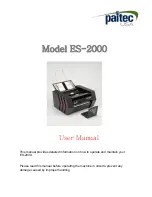
M.I. P/N 004-2163 Rev. C
6
Rho Cuvette
The rho cuvette connects to the system through a cable connected to the front panel. The
cuvette is packaged separately from the rest of the system. See the “
Normal Operation
”
and “
Theory of Operation
” sections for more details on the cuvette. The Cuvette input can
be used to connect a thermodilution sensor to the system. See
“Theory of Operation –
Temperature Measurement”
for instructions. See
“Recommended Accessories”
for
ordering information for the particular connector.
External ECG
The ECG cable will only be used by users who want to measure surface ECG. The Control
Interface is used to select the input to the ECG channel. The ECG cable is available in
different lengths and with different terminations according to user needs. See the
“
Recommended Accessories
” section for ordering information.
P2 – Second Pressure Input
The system can measure two pressure signals simultaneously. If the user wishes to use a
second transducer to measure pressure elsewhere in the body, the second transducer will be
connected to the P2 input on the front panel. Use the Control Interface to select the input
for the second pressure channel.
ADInstruments PowerLab Setup
As shown below, the MPVS
Ultra
connects easily to the ADInstruments PowerLab16/30
using the MPVS
Ultra
– PowerLab cable pack. The cable pack is a set of thirteen BNC-to-
BNC cables specifically sized for connecting these two systems. Ten 9-inch cables are
included for connecting the first ten channels on the MPVS
Ultra
to the first ten channels
of the PowerLab system. A 1-foot cable is included to connect the ECG output to channel
11 of the PowerLab system. Two 3-foot cables are included for connecting the Cuvette
Output and Cuvette Temperature signals to the PowerLab system.
The PVAN
Ultra
analysis software CD also includes an ADI Chart interface file that will
save setup time by providing an interface to record data. A shortcut to the file
MPVS
Ultra
Interface.adiset
will be installed on your Desktop during a normal installation of
the Control Interface. There will also be a shortcut in the Millar branch of the Start menu.
The settings file itself will be installed in the same directory as the Control Interface.
Gettin
g
Started







































